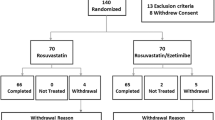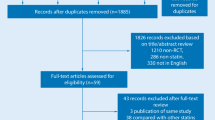Abstract
Background
Hypercholesterolaemia is a risk factor for coronary heart disease (CHD). Clinical studies have shown that lowering elevated serum total cholesterol (TC) levels, and particularly low density lipoprotein-cholesterol (LDL-C) levels, reduces the frequency of coronary morbidity and deaths, whereas high serum levels of high density lipoprotein-cholesterol (HDL-C) protect against CHD. Policosanol is a cholesterol-lowering drug purified from sugar cane wax with a therapeutic dosage range from 5–20 mg/day. Atorvastatin is an HMG-CoA reductase inhibitor which across its dosage range (10–80 mg/day) has shown significantly greater lipid-lowering effects than all previously marketed statins.
Objective
This study was undertaken to compare the efficacy and tolerability of policosanol with atorvastatin in older patients with type II hypercholesterolaemia.
Patients and methods
This randomised, single-blind, parallel-group study was conducted in older patients (60–80 years) with type II hypercholesterolaemia. After 4 weeks on a cholesterol-lowering diet, 75 patients were randomised to policosanol or atorvastatin 10mg tablets taken once daily with the evening meal for 8 weeks. An interim and final check-up were performed at 4 and 8 weeks, respectively, after treatment was initiated.
Results
At 4 (p < 0.0001) and 8 (p < 0.00001) weeks, policosanol 10 mg/day significantly lowered serum LDL-C levels by 17.5 and 23.1%, respectively compared with baseline; corresponding values for atorvastatin were 28.4 and 29.8%. At study completion, policosanol significantly (p < 0.0001) reduced serum TC (16.4%), LDL-C/HDL-C ratio (25.5%) and TC/HDL-C ratio (19.3%), as well as (p < 0.001) triglyceride levels (15.4%). Atorvastatin significantly (p < 0.0001) decreased serum TC (22.6%), LDL-C/HDL-C (26.2%) and TC/HDL-C (19.8%) ratios, as well as (p < 0.001) triglyceride levels (15.5%). Atorvastatin was significantly more effective than policosanol in reducing LDL-C and TC, but similar in reducing both atherogenic ratios and triglyceride levels. Policosanol, but not atorvastatin, significantly (p < 0.05) increased serum HDL-C levels by 5.3%. Both treatments were well tolerated. At study completion, atorvastatin mildly, but significantly (p < 0.05) increased creatine phosphokinase (CPK) and creati-nine, whereas policosanol significantly reduced AST and glucose (p < 0.01) and CPK (p < 0.05) levels. All individual values, however, remained within normal limits. Three atorvastatin but no policosanol patients withdrew from the study because of adverse events: muscle cramps (1 patient), gastritis (1 patient) and uncontrolled hypertension, abdominal pain and myalgia (1 patient). Overall, no policosanol and seven atorvastatin patients (18.9%) reported a total of nine mild or moderate adverse events during the study (p < 0.01).
Conclusions
This study shows that policosanol (10 mg/day) administered for 8 weeks was less effective than atorvastatin (10 mg/day) in reducing serum LDL-C and TC levels in older patients with type II hypercholesterolaemia. Policosanol, but not atorvastatin, however, significantly increased serum HDL-C levels, whereas both drugs similarly reduced atherogenic ratios and serum triglycerides. Policosanol was better tolerated than atorvastatin as revealed by patient withdrawal analysis and overall frequency of adverse events. Nevertheless, further studies must be conducted in larger sample sizes and using dose-titration methods to achieve target lipid levels in order to reach wider conclusions.





Similar content being viewed by others
Notes
Tradename is used for identification purposes and does not imply endorsement.
References
Anderson KM, Wilson PWF, Odell PM, et al. An updated coronary risk profile: a statement for health professionals. Circulation 1991; 83: 356–62
Lipid Research Clinics Program. The lipid research clinics coronary primary prevention trial results: I. Reduction in the incidence of coronary heart disease. JAMA 1984; 251: 351–64
Lipid Research Clinics Program. The lipid research clinics coronary primary prevention trial results: II. The relationship of reduction in the incidence of coronary heart disease to cholesterol-lowering. JAMA 1984; 251: 365–74
Scandinavian Simvastatin Survival Study Group. Randomised trial of cholesterol lowering in 4444 patients with coronary heart disease: the Scandinavian Simvastatin Survival Study (4S). Lancet 1994; 344: 1383–9
Sacks FM, Pfeffer MA, Moy LA, et al., for the Cholesterol and Recurrent Events Trial Investigators. The effect of pravastatin on coronary events after myocardial infarction in patients with average cholesterol levels. N Engl J Med 1996; 335: 1001–9
Tonkin A, Aylward P, Colqhoun D, et al. Prevention of cardiovascular events and deaths with pravastatin in patients with coronary heart disease and a broad range of initial cholesterol levels. N Engl J Med 1998; 339: 1349–57
Downs JR, Clearfield M, Weiss S, et al., for the AFCAPS/TexCAPS Rsearch Group. Primary prevention of acute coronary events with lovastatin in men and women with average cholesterol levels: results of AFCAPS/TexCAPS. JAMA 1998; 279: 1615–22
Shepherd S, Cobbe SM, Ford I, et al. Prevention of coronary heart disease with pravastatin in men with hypercholeste-rolemia. N Engl J Med 1995; 333: 1301–7
Expert Panel of Detection, Evaluation and Treatment of High Blood Cholesterol in Adults. Summary of the second report of the National Cholesterol Education Program (NCEP) Expert Panel on Detection, Evaluation, and Treatment of High Blood Cholesterol in Adults (Adult Treatment Panel II). JAMA 1993; 269: 3015–23
Expert Panel of Detection, Evaluation and Treatment of High Blood Cholesterol in Adults. Executive summary of the third report of the National Cholesterol Education Program (NCEP) Expert Panel on Detection, Evaluation, and Treatment of High Blood Cholesterol in Adults (Adult Treatment Panel III). JAMA 2001; 285: 2486–97
Gotto AM, Assman G, Carmena R, et al. The ILIB lipid handbook for clinical practice. Blood lipids and coronary heart disease. 2nd ed. New York: Internatinal Lipid Information Bureau (ILIB), 2000
Krumholz HM, Seeman TE, Merrill SS, et al. Lack of assoscia-tion between cholesterol and coronary heart disease mortality and morbidity and all-cause mortality in persons older than 70 years. JAMA 1994; 272: 1335–40
Bilheimer DW. Clinical considerations regarding treatment of hypercholesterolemia in elderly. Atherosclerosis 1991; 91: S35–57
Manolio TA, Pearson TA, Wenger NK, et al. Cholesterol and heart disease in older persons and women: review of an NHLBI workshop. Ann Epidemiol 1992; 2: 161–76
Lea AP, McTavish D. Atorvastatin: a review of its pharmacology and therapeutic potential in hyperlipidaemia control. Drugs 1997; 53: 828–47
Jones P, Kafanek S, Laurora I, CURVES investigators, et al. Comparative dose efficacy study of atorvastatin versus simvastatin, pravastatin, lovastatin and fluvastatin in patients with hypercholesterolemia (The CURVES study). Am J Car-diol 1998; 81: 582–7
Black DM, Bakker-Arkema R, Nawrocki JW. An overview of the clinical safety profile of atorvastatin (Lipitor), a new HMGCoA reductase inhibitor. Arch Intern Med 1998; 158: 577–84
Schuster H, Berger J, Luft F. Randomised, double-blind, parallel-group trial of atorvastatin and fluvastatin on plasma lipid levels in patients with untreated hyperlipidaemia. Br J Cardiol 1998; 5: 597–602
Dart A, Jerums G, Nicholson G, et al. A multicenter, double-blind, one-year study comparing safety and efficacy of atorvastatin versus simvastatin in patients with hypercholesterolemia. Am J Cardiol 1997; 80: 39–44
Davidson M, McKenney J, Stein E, et al. Comparison of one year efficacy and safety of atorvastatin versus lovastatin in primary hypercholesterolemia. Am J Cardiol 1997; 79: 1475–81
Laguna A, Magraner J, Arruzazabala ML, et al. Patent Cooperation Treaty EP 937/00007. 1993 Jan 5
Mas R. Policosanol. En Drugs of the Future 2000; 25: 569–86
Pons P, Rodríguez M, Robaina C, et al. Effects of successive dose increases of policosanol on the lipid profile of patients with type II hypercholesterolemia and tolerability to treatment. Int J Clin Pharmacol Res 1994; 14: 27–33
Canetti M, Moreira M, Illnait J, et al. A two years study on the efficacy and tolerability of policosanol in patients with type II. Int J Clin Pharmacol Res 1995; 15: 159–65
Benítez M, Romero C, Más R, et al. A comparative study of policosanol versus pravastatin in patients with type II hypercholesterolemia. Curr Ther Res 1997; 58: 859–67
Más R, Castaño G, Illnait J, et al. Effects of policosanol in patients with type II hypercholesterolemia and additional coronary risk factors. Clin Pharmacol Ther 1999; 65: 6–14
Castaño G, Más R, Fernández JC, et al. Efficacy and tolerability of policosanol compared with lovastatin in patients with type II hypercholesterolemia and concomitant coronary risk factors. Curr Ther Res 2000; 61: 137–46
Castaño G, Más R, Fernández L, et al. Effects of policosanol on postmenopausal women with type II hypercholesterolemia. Gynecol Endocrinol 2000; 14: 187–95
Castaño G, Más R, Arruzazabala ML, et al. Effects of policosanol, pravastatin on lipid profile, platelet aggregation, endothelemia in older hypercholesterolemic patients. Int J Clin Pharm Res 1999; 19: 105–16
Castaño G, Más R, Fernández JC, et al. Effects of policosanol in older patients with type II hypercholesterolemia and high coronary risk. J Gerontol Med Sci 2001; 56: M186–92
Fernández JC, Más R, Castaño G, et al. Comparison of the efficacy, safety and tolerability of policosanol versus fluvastatin in elderly hypercholesterolemic women. Clin Invest 2001; 21: 103–13
Mas R, Castaño G, Fernández L, et al. Effects of policosanol in older hypercholesterolemic patients with coronary disease. Clin Drug Invest 2001; 21: 485–97
Torres O, Agramonte AJ, Illnait J, et al. Treatment of hypercholesterolemia in NIDDM with policosanol. Diabetes Care 1995; 18: 393–7
Crespo N, Illnait J, Mas R, et al. Comparative study of the efficacy and tolerability of policosanol and lovastatin in patients with hypercholesterolemia and non insulin dependent diabetes mellitus. Int J Clin Pharmacol Res 1999; 19: 105–16
Menéndez R, Fernández I, Del Rio A, et al. Policosanol inhibits cholesterol biosynthesis and enhances LDL processing in cultured human fibroblasts. Biol Res 1994; 27: 199–203
Menéndez R, Arruzazabala ML, Más R, et al. Cholesterol-lowering effect of policosanol on rabbits with hypercholesterolemia induced by a wheat starch-casein diet. Br J Nutr 1996; 77: 923–32
Menéndez R, Amor A, Rodeiro I, et al. Policosanol modulates HMGCoA reductase activity in cultured fibroblasts. Arch Med Res 2001; 32: 8–12
Fernández L, Más R, Illnait J, et al. Policosanol: results of a postmarketing surveillance control on 27 879 cases. Curr Ther Res 1998; 59: 717–22
Más R, Rivas P, Izquierdo JE, et al. Pharmacoepidemiologic study of policosanol. CurrTherRes 1999; 60: 458–67
Friedewald WT, Levy RI, Friederickson SD. Estimation of the concentration of low-density-lipoprotein cholesterol in plasma without of the preparative ultracentrifuge. Clin Chem 1972; 18: 499–502
Seigier L, Wu WT. Separation of serum high-density lipopro-tein for cholesterol determination: ultracentrifugation vs precipitation with sodium phosphotungstat and magnesium chloride. Clin Chem 1981; 27: 838–41
Schectman G, Hiatt J. Drug therapy for hypercholesterolemia in patients with cardiovascular disease: factors limiting achievement of lipid goals. Am J Med 1996; 100: 197–204
Nawrocki JW, Weiss SR, Davidson MH, et al. Reduction of LDL cholesterol by 25% to 60% in patients with primary hypercholesterolemia by atorvastatin, a new HMG-CoA reductase inhibitor. Arterioscler Thromb Vase Biol 1995; 15: 678–82
Demir M, Acarturk E, Sasmaz I, et al. Effects of atorvastatin on lipid profile and coagulation parameters. Curr Ther Res 2001; 62: 691–8
Castaás R, Fernño G, Nodarse M, Más R, Fernás R, et al. Estudio comparativo de la eficacia y tolerabilidad del policosanol, la simvastatina y su terapia combinada en el tratamiento de la hipercolesterole-mia tipo II. Rev CENIC Cien Biol 1998; 29: 9–15
Zardova R, Tula L, Castañs G, et al. Effects of policosanol on hypercholesterolemic patients with disturbances on serum biochemical indicators of hepatic function. Curr Ther Res 1996; 57: 568–77
Acknowledgements
This study was supported by a research grant from the West Havana Scientific Pole. Most of the authors have been involved in the development of the policosanol scientific project. No additional payment or reward has been received for conducting this study.
Author information
Authors and Affiliations
Corresponding author
Rights and permissions
About this article
Cite this article
Castaño, G., Mas, R., Fernández, L. et al. Comparison of the Efficacy and Tolerability of Policosanol with Atorvastatin in Elderly Patients with Type II Hypercholesterolaemia. Drugs & Aging 20, 153–163 (2003). https://doi.org/10.2165/00002512-200320020-00006
Published:
Issue Date:
DOI: https://doi.org/10.2165/00002512-200320020-00006




